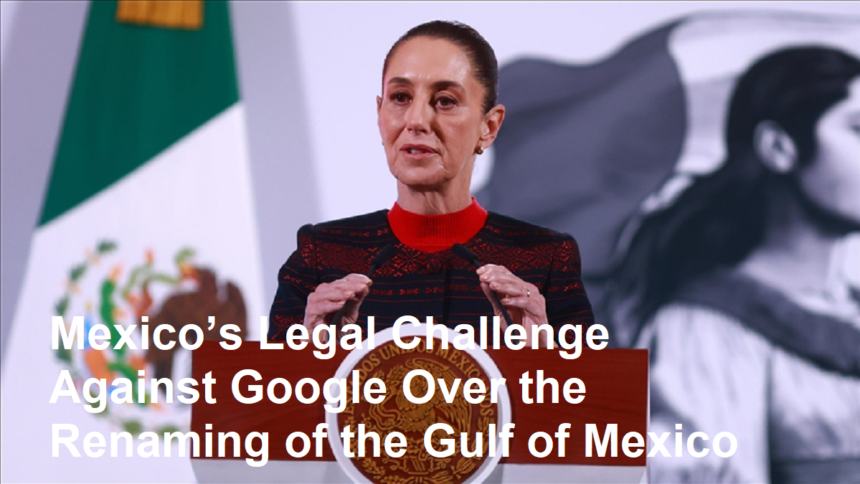On Friday, May 9, 2025, Mexican President Claudia Sheinbaum publicly announced that her government is taking legal action against the technology giant Google. The lawsuit arises from Google’s decision to rename the “Gulf of Mexico” as the “Gulf of America” on its maps platform for users in the United States. This move has sparked significant controversy and diplomatic tension between Mexico and the United States, highlighting the sensitive nature of geographical names and national sovereignty in the digital age.
Background: The Gulf of Mexico and Its Importance
The Gulf of Mexico is a vast oceanic basin bordered by the United States to the north, Mexico to the west and south, and Cuba to the southeast. It is a region of immense ecological, economic, and cultural significance. The gulf supports rich biodiversity, is a hub for oil and gas exploration, and plays a crucial role in the economies of the bordering nations through fishing, tourism, and shipping.
Given its shared nature, the name “Gulf of Mexico” has long been internationally recognized and accepted. It reflects the historical and geographical realities of the region, acknowledging Mexico’s integral connection to this body of water. Any unilateral attempt to rename or rebrand this area can be perceived as a challenge to national identity and territorial rights.
Google’s Name Change and Its Justification
Google’s decision to label the Gulf of Mexico as the “Gulf of America” for users accessing its maps service from the United States stems from what the company describes as a “longstanding practice” of updating place names based on official government sources. According to Google, the change aligns with a naming convention that reflects the U.S. government’s designation of the continental shelf in that region as the “Gulf of America.”
Importantly, Google has clarified that this renaming applies only to users in the United States. For users in Mexico, the label remains “Gulf of Mexico,” and for users in other parts of the world, the map displays a combined label: “Gulf of Mexico (Gulf of America).” This nuanced approach, however, has not alleviated the concerns of Mexican authorities.
Mexico’s Response and Legal Action
Mexico’s government, led by President Claudia Sheinbaum, has strongly opposed Google’s renaming decision. The Mexican Foreign Relations Ministry had previously sent formal letters to Google urging the company to reconsider and refrain from changing the name. These diplomatic efforts, however, did not lead to a reversal of the change.
In February 2025, President Sheinbaum escalated the matter by threatening legal action against Google if the company did not restore the original name. Following Google’s refusal to comply, the Mexican government proceeded with filing a lawsuit, asserting that Google’s actions constitute an infringement on Mexico’s territorial sovereignty and an inaccurate representation of internationally recognized geographical nomenclature.
President Sheinbaum emphasized that the “Gulf of America” label should only apply to the portion of the gulf corresponding to U.S. territorial waters, while the “Gulf of Mexico” name rightfully belongs to the parts adjacent to Mexico and Cuba. She described Google’s unilateral renaming as a distortion of geographical facts and a disregard for Mexico’s historical and legal claims.
Broader Implications: Sovereignty, Technology, and Geographical Naming
This dispute between Mexico and Google underscores the complex intersection of technology, geopolitics, and national sovereignty in the digital era. As global technology companies like Google provide mapping and location services used by billions worldwide, their decisions on place names carry significant political and cultural weight.
Geographical names are not merely labels; they embody history, identity, and legal rights. Changes to these names, especially when done unilaterally by private corporations, can provoke diplomatic disputes and public outcry. The case also raises questions about the authority and responsibility of tech companies in representing contested or sensitive geographical information.
Similar controversies have arisen in the past, such as disputes over the names of bodies of water, regions, or cities where multiple countries or groups claim differing names. These cases often require careful negotiation and adherence to international standards, such as those set by the United Nations Group of Experts on Geographical Names (UNGEGN).
Potential Outcomes and Future Developments
The lawsuit filed by Mexico against Google is still in its early stages, and the outcome remains uncertain. If the court rules in favor of Mexico, it could compel Google to revert to the original naming convention globally or at least for U.S. users. Such a ruling would set a precedent for how technology companies handle geographical names and respect national sensitivities.
On the other hand, if Google’s defense—that it follows official government sources and naming conventions—prevails, it may encourage other countries to push for similar changes or challenge existing names on digital platforms. This could lead to a patchwork of naming conventions depending on user location, potentially causing confusion and further disputes.
Conclusion
President Claudia Sheinbaum’s announcement to sue Google over the renaming of the Gulf of Mexico to the Gulf of America highlights the delicate balance between technological innovation and respect for national sovereignty. The Gulf of Mexico is more than a geographical feature; it is a symbol of Mexico’s heritage and territorial rights. Google’s decision, while rooted in following official sources, has ignited a diplomatic and legal battle that reflects broader challenges in the digital representation of our world.
As this case unfolds, it will be closely watched by governments, technology companies, and users worldwide. It serves as a reminder that in an interconnected world, the power to name places carries profound implications, and respecting those names is essential to maintaining international harmony and mutual respec









